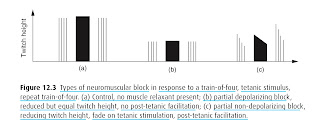Monitoring neuromuscular block
Following stimulation of the relevant nerve.
Nerve stimulators must generate a supramaximal stimulus (60–80 mA) to ensure that all the composite nerve fibres are depolarized.
Duration 0.1 ms.
Negative electrode directly over the nerve. Positive electrode placed where it cannot affect the muscle in question.
Five main patterns of stimulation
Single twitch stimulation
Simplest form
Requires a baseline twitch height
Reduction in twitch height observed until 75% of NMJ receptors have been occupied by muscle relaxant
Only a small number of receptors are required to generate a summated mini end-plate potential, which triggers an action potential
Partial NMJ block with depolarizing muscle relaxants (DMRs) and non-depolarizing muscle relaxants (NDMRs) reduce the height of single twitch stimulation.
Tetanic stimulation
Individual stimuli are applied at a frequency >30 Hz
Twitches observed in the muscle become fused into a sustained muscle contraction – tetany
Most stimulators deliver stimuli of 0.1 ms duration at a frequency of 50 Hz
Partial NDMR the tetanic stimulation fades with time
Partial DMR block reduces but does not exhibit fade
Post-tetanic potentiation and count
Following tetanic stimulation, subsequent twitches are seen to be large
Due to increased synthesis and mobilization of ACh and/or increased Ca 2+ in the synaptic terminal.
Stimuli at 1 Hz are started 3 seconds after a tetanic stimulation
Number of twitches is inversely related to the depth of block
Best used when the degree of receptor blockade is >95%,
Efects of tetanic stimulation may last for up to 6 minutes, may give a false impression of inadequate block to single twitch or train-of-four analysis.
Partial DMR block does not exhibit post-tetanic potentiation.
Train-of-four
Four 0.1 ms stimuli delivered at 2 Hz.
Ratio of the fourth twitch height to the first twitch height (T4:T1): TOF ratio
Number of twitches: TOF count
Does not require a baseline twitch height.
TOF ratio
Partial non-depolarizing muscle relaxant blockade, that is, T 4< T1
Receptor occupancy above 70%- T 4 start to decrease in size.
When T 4 has decreased by 25% - T 1 starts to decrease (75–80% receptor occupancy).
T 4disappears when T 1is approximately 25% of its original height
TOF ratio is diicult to assess in practice.
TOF ratio in the presence of partial DMR block is 1.
TOF count
Receptor occupancy exceeds 90% - T 4 disappears
only T 1is present at 95% receptor occupancy
TOF count assesses the degree of deep NDMR block.
Double burst stimulation
Delivery of two bursts of stimulation separated by 0.75 s.
Three 0.2 ms stimuli separated by 20 ms at a 50 Hz
Easy manual detection of small amounts of residual NMJ blockade
When magnitude of the two stimuli are equal, clinically significant residual NMJ blockade does not exist
No more sensitive than TOF


Comments
Post a Comment
Please share your views and comments in the comment section. Give your opinion if there is anything to update.
Subscribe the channel to get updates regarding regular blog post.
Share the content if you think its appropriate.
Thank you.